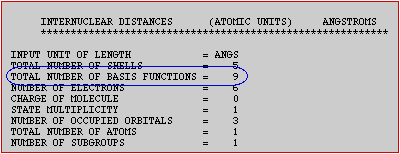|
Home
Basis Sets Lab Activity
Basis Set Main Page
Students
Introduction
Objectives
Background Reading
Procedure
Questions
Further Work
References/Support Materials
Teachers
Additional Background
Materials
Standards
First year chemistry curriculum concepts
Second year chemistry curriculum concepts
Readings
Overview
Atomic Orbitals
Lab Activities
Z-matrices
Basis Sets
Geometry Optimizations
Ionization Energies
Support Materials
Interactive Tools
Glossary of Terms
Quick Guide to DISCO Output File
Related Links
ChemViz
Computational Chemistry
SUCCEED's Computational Chemistry
Developers' Tools
What's New?
Discussion Board
Team Members
Email the Group
Contact Webmaster
|
Procedure:
Group Part:
In order to conduct this lab, you will need a spreadsheet and a Waltz
Interface.
The molecules we are using in this lab are alkanes. They have the formula
CnH2n+2. Alkanes are made up of n carbons linked
together in a line with hydrogens jutting off every carbon. All of the bonds
in alkanes are single bonds. The entire class will be collecting data to use
for analysis. Split up the molecules so that each group will run a geometry
optimization for two molecules. The more molecules the class runs, the better
your results. When dividing up the molecules, skip every third alkane in the
sequence. (ex. CH4, C2H6,
C4H10)
You should set your spreadsheet up as follows:

You will use Waltz to run each molecule THREE times: once with an STO-3G,
once with a 3-21G, and once with a 6-21G.
Once your run has completed, you will need to extract two pieces of
information from the output file,
- The number of basis functions used.

- The CPU time. (Remember that the CPU time is different from the Wall
time. The CPU time is the time it took to complete the run on the
computer. The Wall time is the time it took for you to get your answer back
after you clicked the execute button.)

Class Part:
- Once the class has collected all the data, compile it all into one
spreadsheet.
- Graph the number of basis functions versus the number of carbons in each
molecule. Do this for each of the 3-21G and 6-21G basis sets. You should have
two graphs. What do you observe about the shape of each graph?
- Try to write two equations (one for each basis set) which give the number
of basis functions (bf) for a certain number of carbons (c) plus a certain
number of hydrogens (h). (Clue: Use systems
of equations)
y bf = (a*c) + (b*h)
What are the coefficients (a) and (b) in this equation (both are integers)?
- Let's test your equation. Calculate the number of basis sets needed to
calculate the following molecules.
- Now graph the CPU time, in seconds, versus the number of basis functions
calculated. What relationship do you see? Describe what happens to the CPU
time required as the molecule gets extremely large.
- Try to predict what the CPU time will be for the molecules which haven't
been calculated yet. Each group should take one molecule that had been skipped
earlier and one that is larger than any that have already been tried. How
accurate do you think your predictions are? Do you think that the prediction
for a molecule between two that we calculated is any more or less accurate
than the prediction for a molecule not in between two that we calculated? If
so, why? Discuss the difference between these predictions with your
group. Record your predictions.
- Now, each group should run the calculations for their two
molecules. Record the data and share the results with the class.
|


